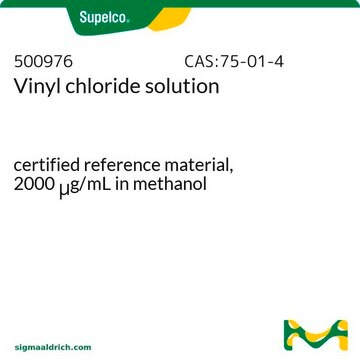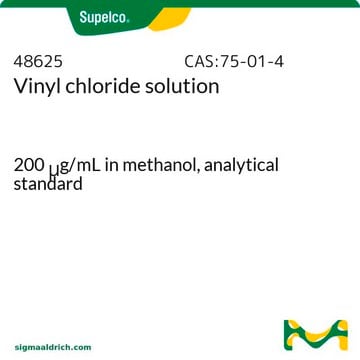13-0822
Hexan
≥96.0%, for residue analysis, JIS 1000
Synonym(e):
n-Hexan
About This Item
Empfohlene Produkte
product name
Hexan, JIS 1000, ≥96.0%, for residue analysis
Qualität
for residue analysis
Agentur
JIS 1000
Dampfdichte
~3 (vs air)
Dampfdruck
256 mmHg ( 37.7 °C)
5.2 psi ( 37.7 °C)
~132 mmHg ( 20 °C)
Assay
≥96.0%
Form
liquid
Selbstzündungstemp.
453 °F
Expl.-Gr.
7.7 %
Verfügbarkeit
available only in Japan
Brechungsindex
n20/D 1.375 (lit.)
pH-Wert
7
bp
69 °C (lit.)
mp (Schmelzpunkt)
−95 °C (lit.)
Dichte
0.659 g/mL at 25 °C (lit.)
SMILES String
CCCCCC
InChI
1S/C6H14/c1-3-5-6-4-2/h3-6H2,1-2H3
InChIKey
VLKZOEOYAKHREP-UHFFFAOYSA-N
Suchen Sie nach ähnlichen Produkten? Aufrufen Leitfaden zum Produktvergleich
Verwandte Kategorien
Signalwort
Danger
Gefahreneinstufungen
Aquatic Chronic 2 - Asp. Tox. 1 - Flam. Liq. 2 - Repr. 2 - Skin Irrit. 2 - STOT RE 2 Inhalation - STOT SE 3
Zielorgane
Central nervous system, Nervous system
Lagerklassenschlüssel
3 - Flammable liquids
WGK
WGK 3
Flammpunkt (°F)
-7.6 °F - closed cup
Flammpunkt (°C)
-22 °C - closed cup
Persönliche Schutzausrüstung
Eyeshields, Faceshields, Gloves, type ABEK (EN14387) respirator filter
Analysenzertifikate (COA)
Suchen Sie nach Analysenzertifikate (COA), indem Sie die Lot-/Chargennummer des Produkts eingeben. Lot- und Chargennummern sind auf dem Produktetikett hinter den Wörtern ‘Lot’ oder ‘Batch’ (Lot oder Charge) zu finden.
Besitzen Sie dieses Produkt bereits?
In der Dokumentenbibliothek finden Sie die Dokumentation zu den Produkten, die Sie kürzlich erworben haben.
Unser Team von Wissenschaftlern verfügt über Erfahrung in allen Forschungsbereichen einschließlich Life Science, Materialwissenschaften, chemischer Synthese, Chromatographie, Analytik und vielen mehr..
Setzen Sie sich mit dem technischen Dienst in Verbindung.












